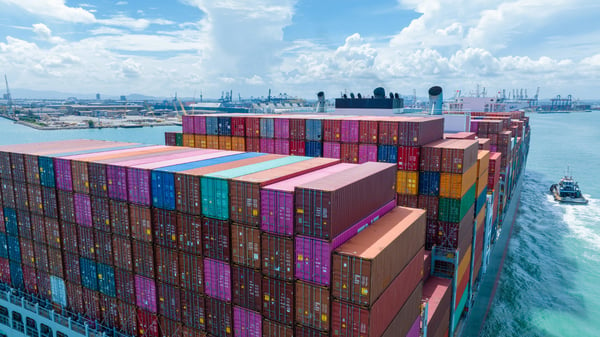On many strategic issues, there is often much to be gained by taking a joined-up approach. Sustainability and risk are two such areas, where more and more people are starting to recognize the potential synergies of cross-functional collaboration. In this article, our experts Cecilia Almér and Max Kollberg take a closer look at the concept of ESGRC and what it has to offer.
ESGRC is a concept that has recently started to gain more traction. As you can probably guess, the acronym is a merger of ESG and GRC. In other words, it means that sustainability, risk and compliance are managed under a common concept. Less obvious, however, is the premise behind ESGRC. Why should ESG and GRC be managed together, what are the benefits and what does it mean in practice for your company?
To answer these questions, we enlist the help of Stratsys' own experts in each area: our sustainability expert and ESG lead Cecilia Almér and GRC lead Max Kollberg.
Exciting synergies
In terms of benefits, Max sees that the ESGRC concept can have a positive impact on several areas in the same organization:
ESGRC can create synergies by coordinating a range of different activities.
- When used to its full potential, ESGRC can help create greater synergies by coordinating a range of activities in a cross-functional way. The benefits span areas such as risk management, corporate culture, resource use and coordination. But they can also extend to longer-term issues such as innovation and competitiveness.

Stratsys GRC lead, Max Kollberg
Cecilia links the increased interest in ESGRC to the growing importance of sustainability:
The fact that more and more people are interested in how ESG and GRC work can be linked is not only due to new and tougher legislation, but also to increased awareness.
- The fact that more people are starting to look at how the work can be linked is not only due to increased awareness in general, but also to tougher legislation from the EU, including within the framework of the EU Green Deal. These are new and more complex regulations. New legislation affects risk management in value chains from a number of perspectives: environmental, social, ethical, economic and so on. In addition, companies are increasingly focusing their sustainability resources on reporting and compliance.
.jpg?width=316&height=310&name=Cecilia%20Alm%C3%A9r_Stratsys%20_talarbild%20(kopia).jpg)
Stratsys ESG lead Cecilia Almér
The sum is greater than the parts
So what is the main purpose of ESGRC? According to Max, it's linked to a need to create a coordinated strategy for the whole company:
- The purpose of ESGRC is to integrate sustainability and risk management into a holistic concept. At the same time, it is a way of responding to a business environment where the need for a coordinated approach is increasing. For example, we can see that investments linked to areas such as cybersecurity and data breaches are increasing in recent years. So the idea is to both work more efficiently and better manage the issues themselves.
Streamlining with ESGRC
So how do our experts see the work in each area becoming more efficient? Max and Cecilia agree that it is both about working in a more coordinated and transparent way in reporting, but also about integrating and valuing sustainability work within the organization. The streamlining means that you can:
- Integrate sustainability risks. Traditionally, risk management focuses mainly on financial and operational risks. With ESGRC, you also integrate sustainability risks. For example, how climate change affects value chains or how labor conditions affect a company's reputation.
- Incorporate sustainability as a core value. By bringing ESG and GRC together, you can give equal weight to ethical commitments and legal requirements. In practical terms, this means that sustainability and risk are not seen as separate processes. This makes sustainability more valued within the company and can help it to be truly integrated into the company's core values.
- Create more transparent reporting. The ESGRC concept can provide better conditions for working systematically with data collection and analysis. This will help your organization meet new and tougher risk and sustainability legislation and targets. An obvious benefit is that it reduces duplication of effort, but above all it results in more transparent reporting that is easier to follow up.
- Achieve better use of resources. Bringing ESG and GRC together also makes it easier to avoid parallel efforts. For example, the sustainability policy developed can simultaneously meet increased governance, risk and compliance requirements. The obvious benefit is that it will be easier to allocate resources and optimize efforts.
Strategic importance
We have now reviewed a range of potential benefits associated with the ESGRC. Just by looking at how work can be streamlined as a result of merging sustainability and risk work, it is clear that there is much to be gained.
What benefits can we see if we look at what ESGRC can mean strategically for you as a market participant? According to Max and Cecilia, they include reducing risks, better decision-making and an opportunity to prepare the company for the future. They highlight the following benefits:
- Strengthened competitiveness. Sustainability and risk management are now strategic issues, with pressure from partners, customers and, not least, regulators placing new demands on you as a business. Succeeding can often be vital for gaining market and investor confidence. It can also strengthen your brand in the long run.
- Reduced risks. The risks associated with poor governance and compliance affect both brand and profitability. A comprehensive ESGRC approach gives you a better chance of both identifying and practically addressing them in a timely manner. Typical sustainability risks include costly environmental incidents, sanctions and other legal penalties, but also loss of investor and customer relationships.
- Better decision-making. As a decision-maker, decisions are often only as good as the evidence available. A lack of a complete picture increases the risk of misjudgements and serious mistakes. With better information, you can make strategic decisions in line with both business and sustainability goals.
- Future proofing. By strengthening the work with ESG and GRC, the company is better equipped for the future. This includes things that are currently unknown or have not happened, such as new legal requirements, technological shifts or market changes. ESGRC can make your organization more resilient and adaptable.
Time for change?
Cecilia emphasizes that it hasn't necessarily been wrong to separate sustainability from risk management, but that the challenges today are different:
We see that companies that dare to take a holistic approach are more successful.
- All companies have different conditions and challenges, but many companies today face similar challenges. Although it was previously reasonable to separate risk management and sustainability management, it is now high time to integrate sustainability risks into the processes and procedures that apply to risk management and thus achieve effective ESGRC work. We see that companies that dare to take a holistic approach are more successful.
So it makes sense to work with ESGRC from an efficiency point of view, but it's also a good idea when the business landscape becomes increasingly complex. Max returns to the long-term benefits of working cohesively:
Through a concept like ESGRC, you can minimize risks, but also be more ready to face other challenges.
- Through a concept like ESGRC, you can minimize risks and ensure compliance. At the same time, you can address other challenges your company faces - challenges related to innovation, branding, competitiveness and long-term profitability.



